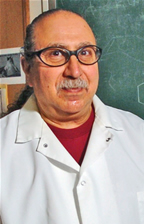Powerful New Machine Eyes Electrons
NSF Funds Purchase of an Electron Paramagnetic Resonance Spectrometer
October 8, 2007
By Russ Hudson
A powerfully magnetic instrument that can peer at electrons orbiting an atom’s nucleus will soon be in the same room as the nuclear magnetic resonance (NMR) spectrometer located in a basement laboratory in McCarthy Hall.
The new instrument, called an X-band electron paramagnetic resonance (EPR) spectrometer, can probe some of the smallest parts of the physical universe, while the also powerfully magnetic NMR can help determine molecular structures by looking at the nuclei of atoms.
“When we have the new instrument installed and working, we hope to try to make it available to other educational institutions via the Web so they can use it, too,” said Harold Rogers, associate professor of chemistry and biochemistry and recipient of a $339,266 National Science Foundation grant funding the EPR purchase.
“We already have a number of universities that share equipment that way through CMolS,” Rogers said, identifying the W.M. Keck Foundation Center for Molecular Structure (CMoIS) overseen by the Department of Chemistry and Biochemistry. “With the NMR and EPR being shared — and what is available at other universities — we’re trying to probe the very structure of matter.”
The NMR and the EPR are so powerful that no credit cards, ZIP disks, digital photo cards or anything else that depends on magnetic recording can be near them. An instant’s exposure within range of either of the machines’ magnetic fields could destroy the information irretrievably. Each machine will be housed in its own space in a large, shielded room that remains locked to anyone not authorized to enter.
It will take about five months for the EPR unit to be built, shipped and installed, said Rogers. The three-year NSF grant also funds ancillary items needed to optimize the utility of the EPR, such a VT unit, optical transmission resonator and a programmable goniometer.
Electrons are like compass needles, Rogers explained. In a compass, the needle will point at magnetic north. If it changes, then there is another magnetic field or high-frequency radio waves coming from another direction and the needle points in that direction. “In the case of electrons, you check the direction of spin,” he said. “We’ll be able to see how electrons react to magnetic fields, how they behave, what they do differently, what changes.
“Depending on the molecule — it has to have an unpaired electron, because paired electrons can’t be observed using this technique — we can put a sample in the NMR to study the properties of the nuclei, then put it in the EPR to get the properties of electrons. We can collect a lot of information that way,” Rogers said.
Geologists, volcanologists, medical researchers and a variety of chemists are among those who can use the EPR in their studies. “The mineral hematite is a good example,” he pointed out. “Hematite has lots of iron, and each iron atom has up to five unpaired electrons. Blood also has iron, so the EPR could be used for medical purposes. EPR also may be used for studies of food and beverages, radiation exposure and for pharmaceuticals.”
Rogers noted yet another use for the new equipment, especially with access via the Web. “We can use it to generate excitement about science in the area’s students. We can’t take a machine like this to a high school, but we can allow students to see how the equipment operates remotely, as long as they are supervised. One thing we’re thinking of using as an example sounds simple, but will work really well because it has all the elements needed to show what the machine can do,” said Rogers, grinning. “A coffee bean.”
Maria Linder, chair and professor of chemistry and biochemistry, sees a great deal of potential with the new instrument, on more than one level.
“Acquiring this equipment expands the technical capabilities of our department and increases the range of research our chemists and biochemists can perform,” she said. “Previously, some of our faculty who needed this equipment for their research had to go to a neighboring university, such as Cal Tech. Now that we have our own instrument, that saves a great deal of time and energy.
“Also, having the instrument in our department expands the possibilities of exposing our students to it and allows us to include its use in our courses.”


